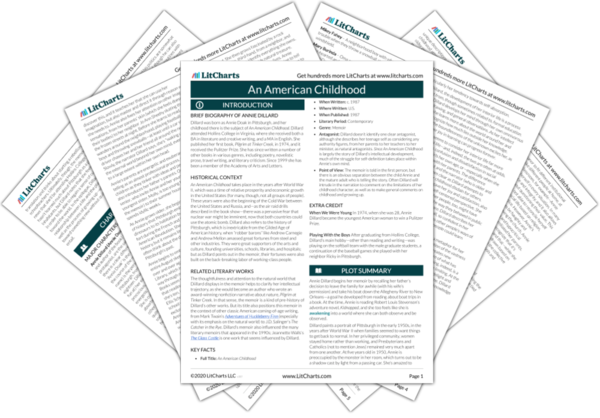Summary
Analysis
Annie Dillard, the author and narrator who is recording her memories from almost forty years before, imagines that when she forgets everything else from her life, she will remember topology: the way her city falls around the mountain valleys, divided by the Allegheny, Monongahela, and Ohio Rivers, and the land where they meet.
Rather than beginning her memoir with a straightforward account of when and where she was born, Dillard chooses to open her book with an evocative recollection of her hometown, discussing the relationship between environment and consciousness.
Themes
Dillard recounts the legend that, centuries earlier, a squirrel could run from one end of Pennsylvania to another without touching the ground by moving across many different kinds of trees. In the middle of the eighteenth century, when Benjamin Franklin and Thomas Jefferson were living in eastern cities, there was not a single English or Indian settlement west of the Alleghenies in Pennsylvania.
Dillard is still fascinated by the long history of Pittsburgh, one that is wrapped up with the history of the United States as a country. While one might think of Pittsburgh as entirely urban, she stresses here that there is a wild, frontier-like quality to the city because of its history.
Themes
In 1753 George Washington decided to make the point of confluence of the Ohio, Allegheny, and Monongahela rivers a fort; later it became a French fort, but not for another ten years would there be any settlers there.
Pittsburgh was a key place in the American Revolution and the French and Indian War, a history that precedes the steel industry the city is known for.
Themes
In 1955, when Annie was ten, her father, an executive in the family firm of American Standard, was inspired by a book called Life on the Mississippi to pilot a boat down the Allegheny river: he quit the firm and sold his stakes, heading toward New Orleans, home of the Dixieland jazz music that he had always loved. Annie was reading Robert Louis Stevens’s book Kidnapped while he was preparing, and she recalls watching him outside on the porch, a dreamy expression in his eyes.
Annie’s description of her father as an executive implies that he is dedicated to a professional and structured life, but as the subsequent depiction of his decision to sail down the Allegheny river implies, he’s more complicated and spontaneous than his job title indicates. Like Annie reading an adventure book, he too wants to go off in search of adventures.
Themes
Get the entire An American Childhood LitChart as a printable PDF.

When Annie’s parents met, Frank Doak was an only child, a lapsed Presbyterian, and a Republican, with an artistic sensibility. He’d listened to jazz, written poems, painted, and acted as a young man. Now as a ten-year old, Annie was sad that, since Frank was quitting his job as a personnel manager, he’d be leaving his 14th-floor building. He sometimes saw suicides jumping from the roof into the river, or being talked out of it by people gathering on the bridge: these stories thrilled Annie and her sister Amy. The colleagues had a betting pool guessing the next date and time a jumper would appear, though it still counted if the person was talked out of it. They would all shout through the window telling him not to.
Frank Doak seems to have been torn in his life between his parents’ expectations for him—expectations he largely followed in shedding his youthful ways and becoming a white-collar employee and executive—and his own artistic dreams. As a child, Annie doesn’t see the tragedy at the heart of the story about the suicides. For her, this is another way her father is still adventurous, while black humor better characterizes his and his colleagues’ responses.
Themes
The morning Annie was reading Kidnapped, her father wandered through the house listening to jazz and snapping his figures. A week later he cheerfully said goodbye to Mother (who was in favor of the plan), his 10-year-old, 7-year-old, and 6-month-old daughters, and started off. After 640 miles he stopped to visit Louisville, Kentucky, and began to feel a little lonely; it was September, so there weren’t other pleasure boats out anymore, and New Orleans was still a few months away. Mother told him that she was getting lonely too, and that people were starting to talk: he prized respectability, so he at once sold the boat and flew home.
The fact that Mother is in favor of Father’s decision to leave his family and small children to travel suggests that she, too, is somewhat of a free spirit. Nevertheless, there are limits to his sense of adventure: both Annie’s parents are not so free-spirited that they disdain what other people think. They are ensconced within a community in Pittsburgh, one that influences their actions even when they choose to break with expectations.
Themes
At ten years old, Dillard relates, children “wake up” in medias res to discover that they already know the neighborhood, they can read, and yet they feel like everything is new. She says that, like all children, she slid into herself perfectly fitted, like a diver into her reflection in a pool. She remembers feeling like she viewed the world as a dizzying precipice, imagining that she was both observer and a possible object of observation herself: a strange but exciting sentiment.
Dillard has a knack for unusual, vivid imagery and metaphors to describe how her childhood felt. Here she attempts to account for the difference between being alive, in a physical, material, sense, and slowly becoming aware of the larger world—a process that takes longer than becoming aware of oneself.
Themes












